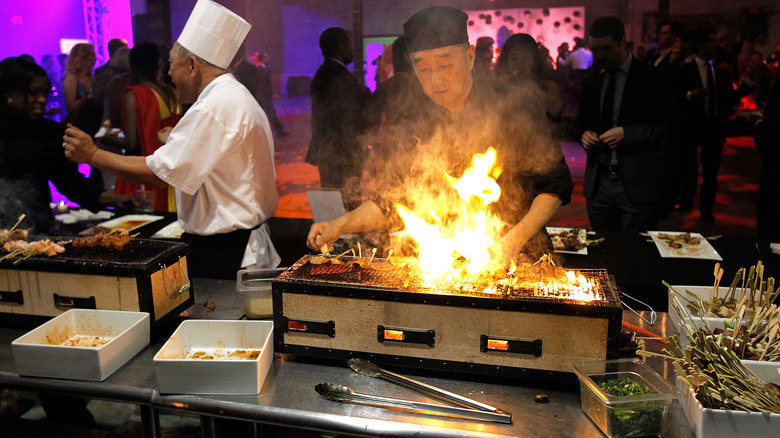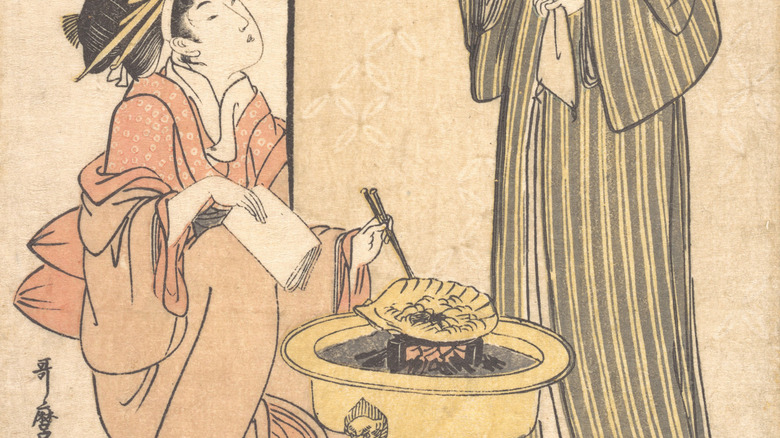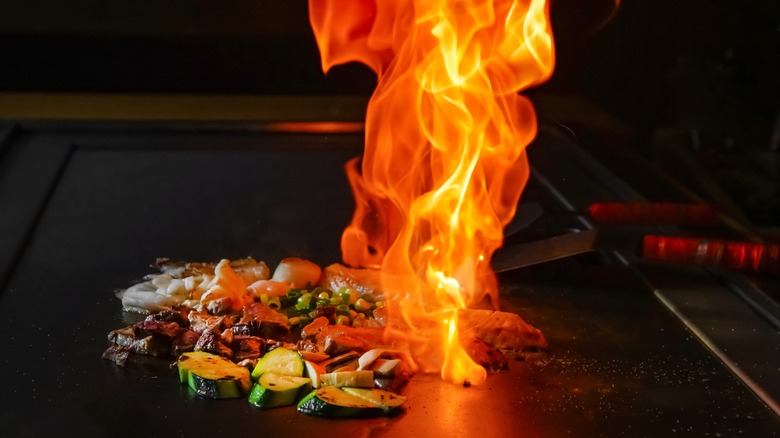The Origin Of Hibachi Restaurants Dates Back To Ancient Japan
Japan has gifted the world with incredible culinary contributions like sushi and sashimi, matcha and miso, and a special method of cooking called hibachi. In the United States, hibachi is known as a delicious Japanese method of cooking that makes steak and vegetables taste better and improves the flavor of fried rice on a flat griddle. However, the flat griddle we know in America is called teppanyaki, while true hibachi uses grated metal grills over an open flame.
Both teppanyaki and hibachi are used in Japanese cooking today, but hibachi can be traced back to ancient origins as early as the Heian period in Japan, from 794 to 1185 B.C. Interestingly, the original purpose of hibachi wasn't cooking but heating a room. The Japanese word "hibachi" is translated to English as "fire pot," and the earliest versions were exactly this — a clay pot or bowl filled with burning charcoal.
Where hibachi originated from
A small clay pot wasn't the most effective method for heating a room or home, but the hibachi proved to be useful for other activities. It could be used to warm up hands on a cold day or to heat small pieces of food or sweets. While cooking wasn't the intended use for the pots, this became more common by the 1800s. It is also thought that during the Edo period from 1603 to 1868, traveling samurai would bring portable clay pots with them to cook on the road.
It's unclear when the small clay pot began to transform into something larger, but a more modern, metal-based hibachi used for cooking emerged in the early 20th century. The size of the hibachi also grew to accommodate cooking for more people.
The hibachi grill was not necessarily replaced by teppanyaki. However, teppanyaki, which translates to "grilling on an iron plate," happened to gain a stronger foothold with foreigners and mainstream cuisine. Misono — a restaurant chain that opened in Kobe, Japan in 1945 — claims to be the first restaurant to have brought teppanyaki to the mainstream dining scene. Tourists were drawn to seeing their food cooked in front of them, and chefs began making the cooking process more theatrical, adding tricks such as the flaming onion volcano.
Modern cooking with hibachi and teppanyaki
Teppanyaki cooking was brought to the United States thanks to the now-famous Benihana restaurant chain. In 1964, four Japanese brothers opened the first location in New York City. Inspired by the success of teppanyaki in Japan with foreigners and being so close to Broadway, the founders continued to refine the showmanship of their chefs by turning the meal into a performance.
At some point, probably when cooking on a teppanyaki grill was introduced to foreigners and brought to America, the terms hibachi and teppanyaki began to be used interchangeably. The cooking methods are similar, so it's understandable how the terms became mixed up. Although it means something different in Japan, hibachi-style cooking is now an American term for cooking food on a teppanyaki plate, typically in front of guests with theatrics and an open flame. It is possible to find a Japanese restaurant in the U.S. with hibachi grills, but most are powered by electricity rather than coals to make them safe for indoor cooking.


